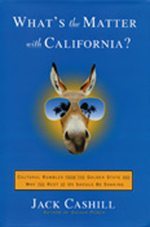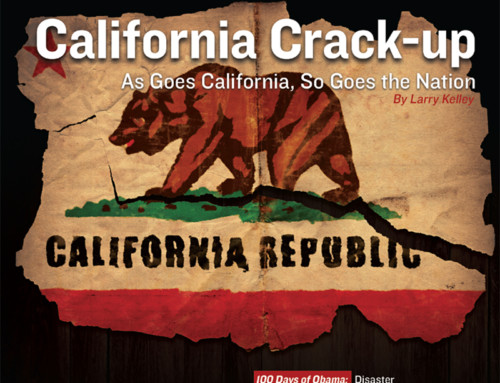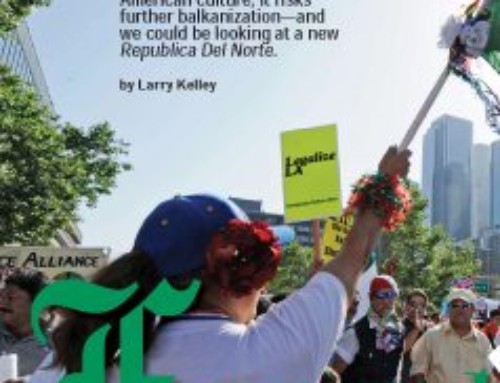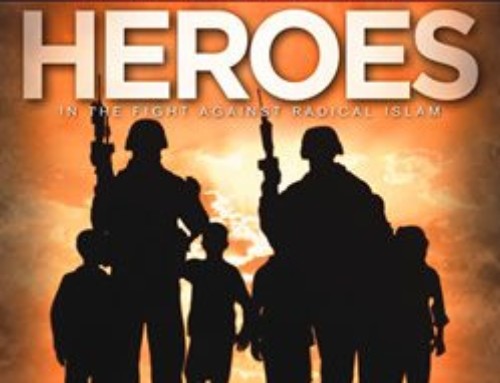Jack Cashill is a national treasure. His latest book, What’s the Matter with California: Cultural Rumbles From the Golden State and Why the Rest of Us Should Be Shaking, is a highly informative and an important commentary.
I recently caught up to Cashill at a speaking engagement at a gathering of San Francisco Bay Area Republicans. He was clearly enjoying his role as one part entertainer, two parts investigative reporter extraordinaire. With a beaming smile he told his audience, “You know, if you ask the average guy from Ohio, ‘What’s the matter with Ohio?’ he’ll say, ‘I dunno. Is there something wrong with Ohio?’
“But if you ask the average Californian, ‘What’s the matter with California?’ he’ll usually come back with two responses: ‘Where do I begin?’ and ‘How much time do you have?’”
Golden State Pathologies
This banter drew a hearty knowing laugh from the Golden State audience.
As a native Californian, I’ve grown up witnessing the growth of all the pathologies Cashill enumerates in his new book, from our soaring crime rate, illegitimacy and white flight, to the rapid hybridization of our culture. But what makes his new book so insightful is that his exceptional investigative skills allow him to divine the single, most primary cause underlying all my home state’s negative phenomenon: fatherlessness. Additionally, he even marks the year, 1969, and the event, California’s enactment of no-fault divorce, as the exact beginning of the state’s grotesque balkanization.
In What’s the Matter With California? Cashill describes an epiphany he experienced while jogging through Beverly Hills several years ago. He noticed that every house was a walled fortress with signs warning of armed guards, dogs and roving security patrols. Yet in his hometown of Kansas City, in the most exclusive neighborhood, Mission Hills, there are no walls, no guards and most people don’t even lock their doors. Why the stark difference? The answer he found lies within the investigation of a very specific event that also took place in 1969 and that shook Hollywood’s bedroom community: the Manson murders.
Cashill coins a term for why virtually all the sociologists, intellectuals and media pundits who write about California cannot see the root cause of its problems. He calls it the ABETTO factor, which is an acronym for “A Blind Eye to the Obvious.” He contends that virtually all those who have interviewed the nice looking, well-spoken co-eds such as Susan Atkins, who killed Sharon Tate and perpetrated the Manson killings, described them as “free spirits” who just wanted to “shake off bigotry” and “experience new age” this or that. But Cashill points out that, if you read Susan Atkins’ book, Child of Satan, or interview any of the other murderous Manson concubines, they all describe childhoods in which their families collapsed and their fathers disappeared.
Cashill goes on to build his case against fatherlessness by pointing out that in 1980, 11 years after the state’s enactment of “no fault divorce,” there were a staggering 276,000 divorces in the state. While this was becoming a big problem for middle- class Californians, divorce and paternal abandonment was a catastrophe for the inner cities.
Murder-Rate Jump
Again, in the fateful year of 1969, two African-American 16-year-olds, Raymond Washington and Stanley “Tookie” Williams formed a neighborhood watch group that was ultimately to become the massive crime and murder machine, the Crips. Both boys were born in 1953 when the entire state experienced 275 murders. In 1979, 25 years later, Washington was killed by a drive-by shooter, Williams was arrested and charged with numerous murders for which he was ultimately executed. By that year, 1979, there were 3,412 murders in the state, a 14-fold increase! And today, Cashill contends, there have been more murders in Los Angeles County over the last four years than all the American troops killed in Iraq.
Despite its morbidity, Cashill’s witticisms make this new book a fun read. Speaking of Los Angeles County, he points out that one-fourth of the country’s most populous state lives in Los Angeles County. And he concludes that, due to the worldwide reach of American media, movies, music and television centered there, los Angelinos have more influence on world culture than any other group since Imperial Rome. While some might argue their influence is now resulting, in many quarters of the world, in revulsion and murderous backlash, the comparison to late Roman antiquity is apt given that the whole state is unwilling to defend its borders and that L.A. is one massive sanctuary city where one out of two babies born at L.A. General is born to illegal parents.
Some of the consequences of this uncontested invasion of L.A. can be witnessed in the recent Adam Sandler movie, Spanglish. In the film, the “drop-dead gorgeous” Paz Vega plays a Mexican woman who illegally enters the U.S. only to find her relatives living in a very expansive “Mexicanized” section of L.A. As Cashill puts it, the aim of the movie is to gently propagandize for the benignity of illegal immigration. Yet it unwittingly shows that there are now vast portions of the state where American culture has been supplanted by a new Latino hybrid culture.
After his talk and lively “q and a” session, I asked Jack if he thought that Bill Clinton was the most corrupt individual ever to hold the presidency.
“I would say that his corruption was easily the most consequential,” he said selecting his words carefully. I don’t know if Warren Harding was any more or less corrupt, but Clinton had eight years of unparalleled resources and the consequences are severe. They include the rearming of the Peoples Republic of China and, I believe, 9/11.”
“Given that Hillary is the likely candidate, do you see how your body of work might have an impact on the election?”
“What I’ve proposed to several publishers and am negotiating right now is a book that will be timed to come out right before the conventions and that will be the ‘swift boat’ book of 2008.”
Consequences of Bad Governance
What Cashill makes plain in his new book is that bad governance in California has had very bad consequences for the quality of life here. Moreover, if you are an apologist for bad governance, there are some consequences about which you can equivocate or attempt to minimize. But a soaring murder rate is not one of them.
In his new book, What’s the Matter With California, Cashill is writing about and advocating for the survival of the traditional American way of life. And in that sense, his books on Flight 800 and Ron Brown’s death are parts of that larger advocacy.
NOTE: Publication: Human Events





